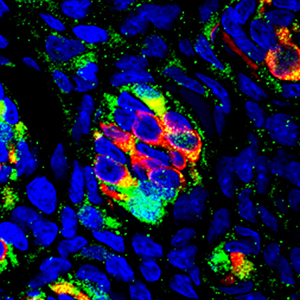Expression profile of the zinc transporter ZnT3 in taste cells of rat circumvallate papillae and its role in zinc release, a potential mechanism for taste stimulation

Accepted: 28 October 2022
Supplementary: 65
HTML: 25
All claims expressed in this article are solely those of the authors and do not necessarily represent those of their affiliated organizations, or those of the publisher, the editors and the reviewers. Any product that may be evaluated in this article or claim that may be made by its manufacturer is not guaranteed or endorsed by the publisher.
Authors
Zinc is an essential trace element, and its deficiency causes taste dysfunction. Zinc accumulates in zinc transporter (ZnT)3-expressing presynaptic vesicles in hippocampal neurons and acts as a neurotransmitter in the central nervous system. However, the distribution of zinc and its role as a signal transmitter in taste buds remain unknown. Therefore, we examined the distribution of zinc and expression profiles of ZnT3 in taste cells and evaluated zinc release from isolated taste cells upon taste stimuli. Taste cells with a spindle or pyriform morphology were revealed by staining with the fluorescent zinc dye ZnAF-2DA and autometallography in the taste buds of rat circumvallate papillae. Znt3 mRNA levels were detected in isolated taste buds. ZnT3-immunoreactivity was found in phospholipase-β2-immunopositive type II taste cells and aromatic amino acid decarboxylase-immunopositive type III cells but not in nucleoside triphosphate diphosphohydrolase 2-immunopositive type I cells. Moreover, we examined zinc release from taste cells using human transient receptor potential A1-overexpressing HEK293 as zinc-sensor cells. These cells exhibited a clear response to isolated taste cells exposed to taste stimuli. However, pretreatment with magnesium-ethylenediaminetetraacetic acid, an extracellular zinc chelator - but not with zinc-ethylenediaminetetraacetic acid, used as a negative control - significantly decreased the response ratio of zinc-sensor cells. These findings suggest that taste cells release zinc to the intercellular area in response to taste stimuli and that zinc may affect signaling within taste buds.
How to Cite

This work is licensed under a Creative Commons Attribution-NonCommercial 4.0 International License.
PAGEPress has chosen to apply the Creative Commons Attribution NonCommercial 4.0 International License (CC BY-NC 4.0) to all manuscripts to be published.

 https://doi.org/10.4081/ejh.2022.3534
https://doi.org/10.4081/ejh.2022.3534






